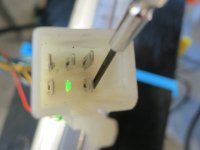I only found 1/8" angle myself for your clamping dropouts dogman. I'm also using grade 5 bolts. I'm running 88v, 65amps, 140 phase into my HS. No problems so far. I see what you mean about the 1/8" bending a bit when you tighten the clamping bolts to the axle. I can't see any gaps between the angle and the axle along the length.
I'm hoping since the width of the angle iron is 1.5" grabbing the entire axle that will compensate for the angle being only 1/8". Did you have any failure with the thinner angle or did you just change it for the bending when tightening the bolts?
I got doctor bass torque arms and rev 4 ebike.ca torque arms as well and with each there is a small amount of play on my axle and with regen I just don't trust them anymore. I really like your clamping dropout. If I can find thicker angle and get the one side bonded on with jp weld / dp420 or even better welded right to the frame it would be perfect.
Why hasn't someone made clamping torque arms commercial yet?
I'm hoping since the width of the angle iron is 1.5" grabbing the entire axle that will compensate for the angle being only 1/8". Did you have any failure with the thinner angle or did you just change it for the bending when tightening the bolts?
I got doctor bass torque arms and rev 4 ebike.ca torque arms as well and with each there is a small amount of play on my axle and with regen I just don't trust them anymore. I really like your clamping dropout. If I can find thicker angle and get the one side bonded on with jp weld / dp420 or even better welded right to the frame it would be perfect.
Why hasn't someone made clamping torque arms commercial yet?






